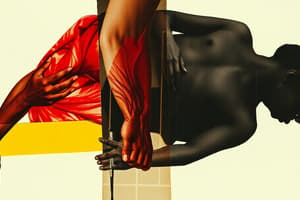Podcast
Questions and Answers
What is the most common type of burn in the 0-4 age group?
What is the most common type of burn in the 0-4 age group?
- Partial thickness burns (correct)
- Full-thickness burns
- Superficial burns
- Thermal burns
What percentage of burn injuries resulted in hospitalization in 2013-2014?
What percentage of burn injuries resulted in hospitalization in 2013-2014?
- No data available
- 50%
- 20%
- 5430 (correct)
Which of the following is a characteristic of a minor burn?
Which of the following is a characteristic of a minor burn?
- Burns that are circumferential
- Burns that affect the face
- Burns that have healed within 2-3 weeks
- Burns that cover less than 10% of the body (correct)
What is the most common cause of burns in the pre-hospital field?
What is the most common cause of burns in the pre-hospital field?
What is the percentage of Aboriginal and Torres Strait Islander people who made up all burns cases?
What is the percentage of Aboriginal and Torres Strait Islander people who made up all burns cases?
What is the highest rate of burn injury in?
What is the highest rate of burn injury in?
What is the consequence of cold exposure in burns?
What is the consequence of cold exposure in burns?
What is the proportion of chronic wounds among all burns cases?
What is the proportion of chronic wounds among all burns cases?
What is the primary factor that determines the severity of decontamination?
What is the primary factor that determines the severity of decontamination?
What is a potential long-term effect of ionising radiation?
What is a potential long-term effect of ionising radiation?
What is a common manifestation of electrical burn damage in the skeletal system?
What is a common manifestation of electrical burn damage in the skeletal system?
What is the primary mechanism by which electrical energy causes tissue damage?
What is the primary mechanism by which electrical energy causes tissue damage?
What is the primary goal of measuring the surface area of a burn during initial management?
What is the primary goal of measuring the surface area of a burn during initial management?
What is the approximate voltage of a lightning strike?
What is the approximate voltage of a lightning strike?
What is the recommended approach for managing burns with blisters?
What is the recommended approach for managing burns with blisters?
What is a pharmacological option for managing pain in burn patients?
What is a pharmacological option for managing pain in burn patients?
Flashcards are hidden until you start studying
Study Notes
Minor Injuries and Burns
Types of Injuries
- Lacerations
- Abrasions
- Avulsions
- Crush injuries
- Bites
- Punctures
- Superficial burns (less than 10% of total body surface area)
- Partial thickness burns
- Full-thickness burns
Epidemiology of Burns
- In 2013-2014, there were 5430 hospitalizations from burn injuries in Australia
- 2/3 of burn victims were male
- Highest rate of burn injury was in the 0-4 age group for both boys and girls
- Aboriginal and Torres Strait Islander people made up 9% of all burns cases and had a higher rate of hospitalization than other Australians
Pathophysiology of Burns
- Homeostasis → inflammation → proliferation → remodelling or maturation
Implications of Burns
- Burns >10% (minor burns are less than 10%)
- Burns that do not affect the face, genitals, or are circumferential
- Burns that have not healed within 2-3 weeks
- Burn shock (to be discussed in other units)
- Burns with respiratory involvement
- Older adults or young children with burns
- Acute versus chronic wounds (chronic wounds account for 2%)
- Diabetics are prone to wounds
- Elderly patients often have comorbidities
- Immunocompromised patients are more susceptible to burns
- Sepsis is a possible complication of burns
Classification of Burns
- Thermal burns: Account for the majority of burns, caused by prolonged contact with direct heat
- Cold exposure: Frostbite, can lead to intravascular thrombosis and tissue hypoxia
- Chemical burns: Caused by direct contact with a caustic chemical agent, can cause continuous tissue destruction
- Radiation burns: Include sunburn and radiation exposure, can be deep and lead to cancer due to DNA damage
- Electrical burns: Caused by electrical current flowing through the body, resulting in tissue damage and necrosis
Management of Burns
Non-Pharmacological Management
- Reduce heat and tissue injury by irrigating the burn
- Dust off chemicals for chemical burns
- Leave blisters intact for burns with blisters
- Cover the burn with cling wrap (avoid circumferential constriction)
- Consider using Burn Aid dressing
- Minor burns are painful, consider using nurofen for anti-inflammatory properties
- Consider escalating pain management and fluid requirements based on the percentage of surface area and depth of the burn
Pharmacological Management
- Anti-inflammatories
- Opioids
- Methoxyflurane
- Burn aid
- Topical wound treatments: alginates, antimicrobial hydrofibers, hydrocolloid foams, gels
Studying That Suits You
Use AI to generate personalized quizzes and flashcards to suit your learning preferences.



